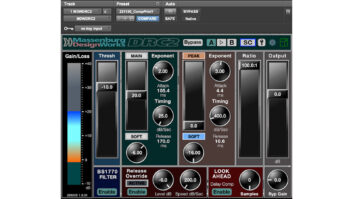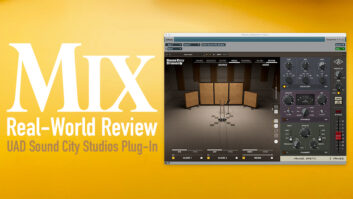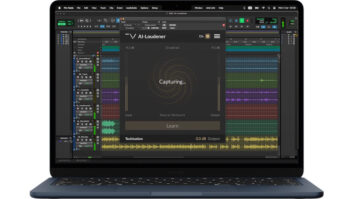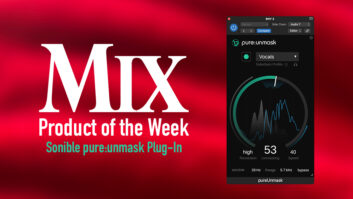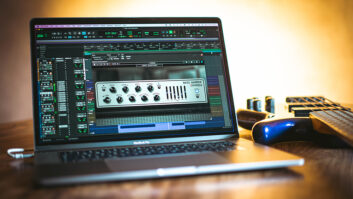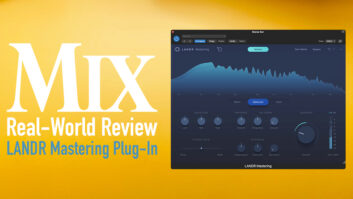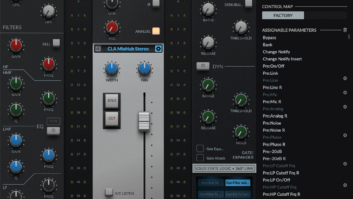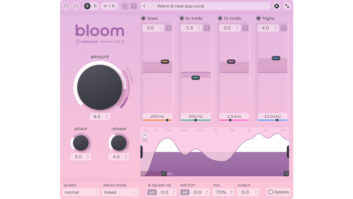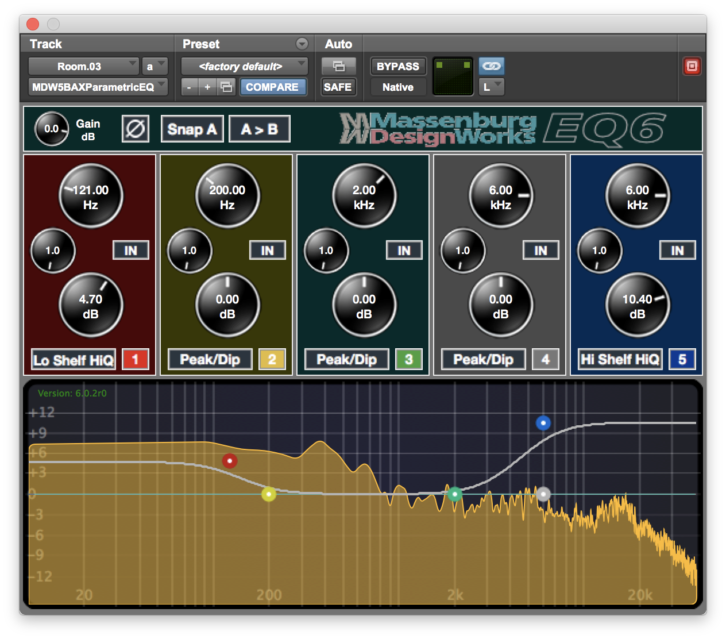
The Massenburg DesignWorks MDWQ6-AAX Hi-Res Parametric EQ Plug-in for Pro Tools is a significant upgrade from version 5, with operational and graphical interface enhancements and four new filters. It retains the familiar and efficient operation of the previous version, though version 6 required a laborious redesign and more than a year of testing and refinement in order to include many asked-for additions from end users.
MDWEQ6-AAX operates either Native AAX or AAX-DSP in Pro Tools, running either in 64-bit Windows PC systems or in Macs (32- or 64-bit) running OS X 10.7 or higher, including OS X 15 Catalina. Presets developed in version 5 will run perfectly in 6; however, you can have only one version at a time in the plug-in folder in Pro Tools.
MDWEQ6 requires Pro Tools 10.3.6 or higher for Macs or PT version 11.1 or higher for Win PCs. It uses iLok 2 or 3 authorization. At the time of this review, there were no development plans for Sonnox or UAD versions.
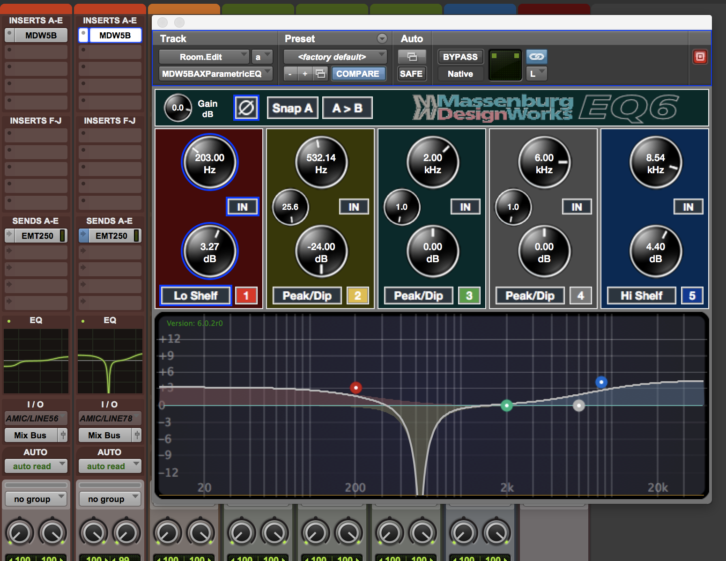
The Original
MDWEQ6 is built on the original MDW filter structure with the constant-shape reciprocal filter curves of the parametric equalizer as originated and conceived by George Massenburg in 1969. The first commercially available hardware parametric EQ was manufactured by International Telecomm, Inc. It was the ITI MEP-130 console module; later the 2U standalone ITI ME-230 model came out. Later, George Massenburg started his own company to produce the GML 8200 five-band stereo parametric equalizer.
The MDWWQ6 is a digital realization of the GML 8200 Series II units. It is significant that all five bands overlap one another, with each band having an operating range of 10 Hz to 41 kHz. All bands are capable of ±24dB boost/cut, with bandwidth or stated Q values from 0.1 to 25.6. The MDWEQ6 uses double-precision, 64-bit floating-point math for all sample rates. For 44.1 and 48kHz sessions, it up-samples to either 88.2 or 96 kHz (respectively) for processing.
Up-sampling and double-precision improves the high-frequency response at near the Nyquist frequency for digital audio, and the plug-in’s great dynamic range allows for huge boosts without clipping. For session rates of 88.2, 96, 176.4 or 192 kHz, no up-sampling is required.
High-resolution processing and double-precision requires vast amounts of DSP resources that must be pre-allocated in AAX-DSP coding. At 44.1/48 kHz, you can have up to seven mono instances per DSP chip, six at 96 kHz and three for 192kHz sessions. Stereo instances count as two mono instances; the number of native instances is only limited by your computer’s CPU capabilities. I had no issues running many instances of both AAX-Native and AAX-DSP at the same time.
Like version 5, there are both three-band and five-band variants, with the three-band consuming about 30 percent less DSP resources. When replacing an instance of the three-band with the five-band variant, all parameter values transfer.
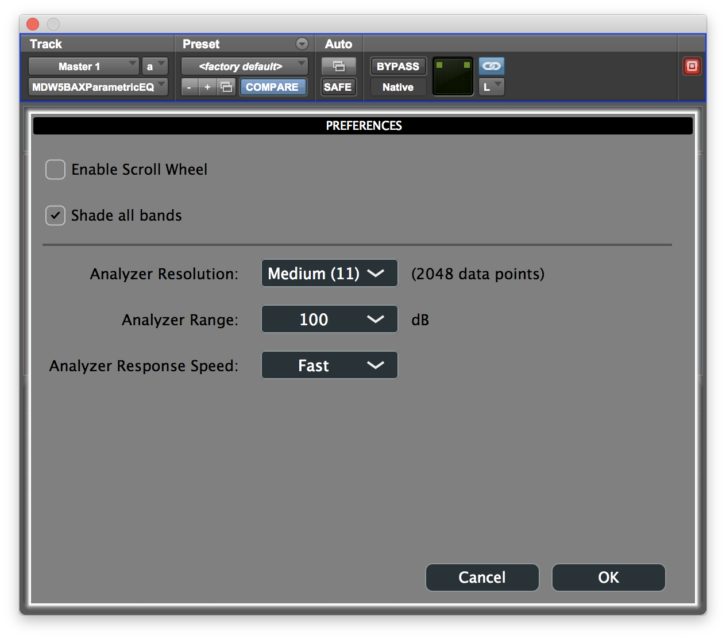
Exacting, Succinct Operation
The top of the MDWEQ plug-in window has the controls: Input Gain, Polarity (Ø) flip, Snapshot A/B selector, settings copy A to B and B to A, and over on the right is the new “Gear” button to access global Preferences. MDWEQ6’s curve updates Pro Tools’ EQ Curve display if you have it selected in the PT Mix window—versions 2018 onward.
By far the most striking change is the larger overall size of the GUI, with an active real-time spectrum analyzer that occupies the entire lower half of the plug-in window. Superimposed over the analyzer are the different color-coded band EQ curves with control “nodes” or handles for clicking and dragging them into shape and position.
You may freely click and drag a node in any direction and see the parameter values change in the center of the band’s control knobs, confirming changes in both frequency and boost/cut values simultaneously. You may also type in specific values for frequency, Q and boost/cut directly into the center of the control knobs.
I like the new ToolTip feature for changing the color of the spectra itself within the analyzer display. The ToolTip button displays a pop-up menu with the color value given in hexadecimal code. But no worries, as you can click on an area in a “rainbow bar” to choose any color you like. I typed in hex FFFFFF, or white; it contrasted well with the shaded areas under each of the five band curves.
Measurement Scaling & Analyzer Prefs
Right-clicking anywhere on the analyzer window reveals choices for its vertical amplitude scaling, with ±6dB, ±12dB or ±24dB choices. You would want to see a ±6dB scale for a mastering EQ, but perhaps the ±12 or ±24dB scales are better when mixing, sound designing or just crazy EQ carving.
Clicking on the Gear symbol pulls up a large Global Preferences window with check boxes for enabling your mouse or trackball’s wheel to adjust parameters. There is a choice between two Band Shading behaviors with the default always on, but you can have it on only while adjusting a band—my preference is to see a band’s curve change when overlapped by another band’s curve.
The Preferences window also has three analyzer parameters for adjusting its visual resolution, dynamic range and response speed. Resolution is adjustable for up to 8,192 measurements for a better “look” at the low frequencies, but at the expense of more CPU usage.
Range sets the dynamic range of the measurement utilizing the entire height of the display’s window, with the noise floor at the bottom and peaks at the top. I preferred the maximum of 120 dB to see the noise floor. Response speed sets the fall time of the display. Set on Slowest, you may inspect spectra for longer durations.
New, Bigger Collection of Filters
Both of the three- and five-band MDWEQ6 equalizer variants are similarly configured. Each band has a separate In/Out button for fast A/B, and each band has a selectable filter-type drop-down menu; they all start with: Bypass, Peak/Dip, Hi shelf, and Lo shelf filter types.
Bands 2, 3, and 4 of the five-band version, and Band 2 in the three-band version can be set to any of nine different filter types, including the same first- and second–order (6 and 12dB/Oct) High-Pass and Low-Pass filters from version 5.
With version 6, both filter bands 1 and 5 for the five-band, and bands 1 and 3 in the three-band are identical and can be individually set to one of 13 different filter types. Back in version 5, the first four bands all had the same collection of seven filter types.
Now in Band 1 and 5, besides the previous version’s collection of filters that included traditional first- and second-order filters, it now has third- and fourth- order (18 and 24dB/Oct) High-Pass and Low-Pass filters.
Now all bands also include Lo Shelf Hi-Q and Hi Shelf Hi-Q filters. These shelving filters offer response curves that are reminiscent of vintage tube passive equalizers when simultaneously boosting and cutting the same frequency.
When right-clicking on any EQ band, a pop-up window includes copy/paste functionality where any band’s settings can be copied/pasted to any other band. There are also four choices for setting the Q for the IsoPeak feature (introduced in version 5) for that particular band. The default Q is 8 but changeable to 4, 12 or 24.
In the Studio
I tested both the three- and five-band MDWEQ6-AAX version 6.02r10 equalizers in Pro Tools 2020.3.0 Ultimate in a 2010 MacPro 5,1 dual four-core. Most of my sessions are at 48 kHz or 96 kHz, and even with this ten-year old computer, I found good stability and solid operation from the beginning.
Subtractive EQ workflows for finding resonances and problematic frequencies are fast and easy using IsoPeak. When you click on a band number button, IsoPeak solos that band and puts a 12dB boost/peak wherever that band’s frequency node is located.
I would drag the node to sweep through frequencies in the general area of the problem or sweep from 10 Hz to 41 kHz and locate other resonances, or just to find frequency centers of interest. I just loved the ability to overlap another band!
I got into the habit of first matching the band’s Q with IsoPeak’s selected Q before developing a subtractive EQ. When I exited IsoPeak, I was ready to cut or boost more precisely and exactly at the chosen frequency and Q.
The new Hi Shelf Hi-Q and Lo Shelf Hi-Q proved very useful and musical in my mixing work. For a thin bass guitar track that sounded rolled-off and midrange-y, in Band 2 I used the Lo Shelf Hi-Q set to 66 Hz with a Q of 8 and up to -12dB of cut.
The fairly sharp resonant peak at 66 Hz fattened the bass up immensely, with up to a +9dB boost indicated on the analyzer’s scale! Then I used a fourth-order highpass filter down the octave at 33Hz in Band 1. To clean up the treble, I added a fourth-order Lo Pass filter in Band 5 at 1.5 kHz. Even with these huge numbers, the MDWEQ6 was very smooth, with the bass louder, clearer and not at all unnatural-sounding!
Drums, Vocals, Everything Else
I like to start my EQ process using Band 2. I would often need the third- or fourth-order filters in Band 1 in addition to what I already had going on. Starting with Band 2 saves me time.
I had a poorly recorded drum kit that needed major MDWEQ6 surgery. For drum equalizing, I set the Analyzer Response Speed to slowest so that I could see the ring-out of sustaining drums and cymbals. I found the MDWEQ6 transparent and clean; extreme EQs on kicks and snares and radical tom-tom filtering still sounded natural—especially noticeable in loud transients and cymbal crashes that can easily distort equalizers.
For a female dance-pop singer’s lead vocal, I was able to carefully dial in a beautiful sound quickly. It is possible to push midrange frequencies in an elegant way so that the vocal sits better within a big and busy backing track. The equalizer’s inherent clarity and flexibility is a big help in achieving this.
As the hardware GML 8200 has garnered a reputation as a mastering EQ, so will the MDWEQ6-AAX. I just finished a legacy project and used the MDWEQ6 to master 10 songs for streaming services. Between using IsoPeak and all five bands, it was amazing to see how much I could help this patchwork of disparate songs become a cohesive set. Considering that I’m not a mastering engineer, using the MDWEQ6-AAX got me through the job successfully.
So Impressive!
The MDWEQ6 makes the process of applying and evaluating equalization more exacting, intuitive and musical. Whether you approach the process of equalization with a strict and surgical mindset to fix problems or as an essential tool in achieving euphonic perfection, the MDWEQ6-AAX will help you do it to the highest possible quality. Awesome!
Product Summary
Company: Massenburg Design Works
Web: https://massenburgdesignworks.com/
Product: MDWEQ6-AAX Plug-in
Price: $299 new; $99 upgrade after relinquishing Version 5
Pros: Amazingly clear and musical sound
Cons: None
